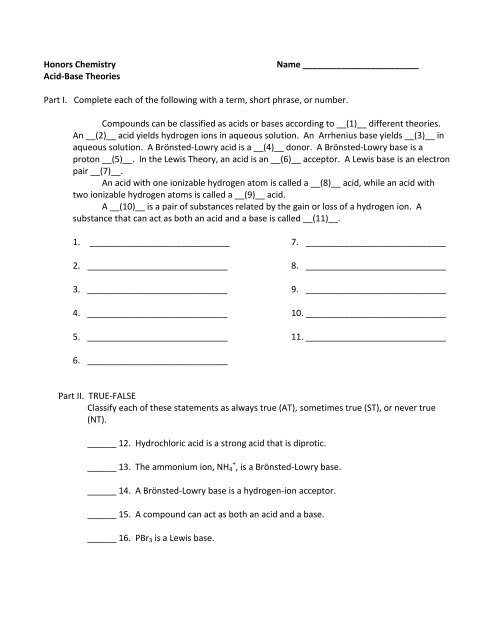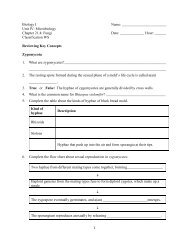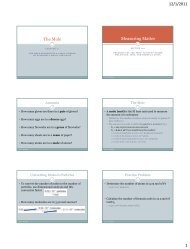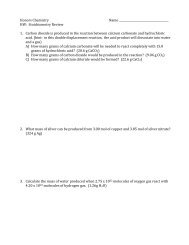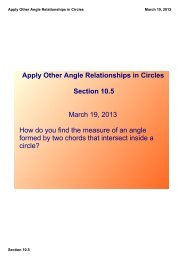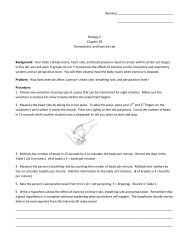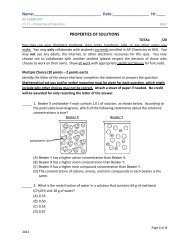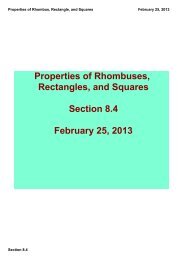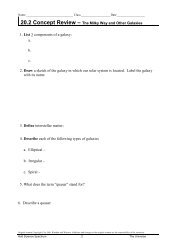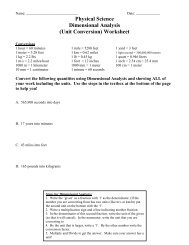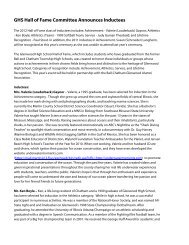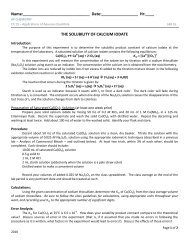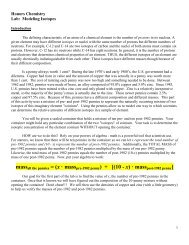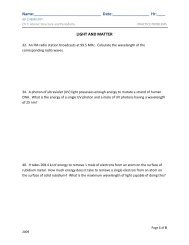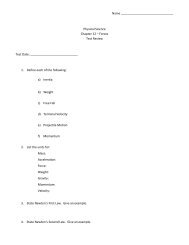Acid-Base Theories WS - Honors Chemistry
Acid-Base Theories WS - Honors Chemistry
Acid-Base Theories WS - Honors Chemistry
You also want an ePaper? Increase the reach of your titles
YUMPU automatically turns print PDFs into web optimized ePapers that Google loves.
<strong>Honors</strong> <strong>Chemistry</strong><br />
<strong>Acid</strong>-<strong>Base</strong> <strong>Theories</strong><br />
Name ________________________<br />
Part I. Complete each of the following with a term, short phrase, or number.<br />
Compounds can be classified as acids or bases according to __(1)__ different theories.<br />
An __(2)__ acid yields hydrogen ions in aqueous solution. An Arrhenius base yields __(3)__ in<br />
aqueous solution. A Brönsted-Lowry acid is a __(4)__ donor. A Brönsted-Lowry base is a<br />
proton __(5)__. In the Lewis Theory, an acid is an __(6)__ acceptor. A Lewis base is an electron<br />
pair __(7)__.<br />
An acid with one ionizable hydrogen atom is called a __(8)__ acid, while an acid with<br />
two ionizable hydrogen atoms is called a __(9)__ acid.<br />
A __(10)__ is a pair of substances related by the gain or loss of a hydrogen ion. A<br />
substance that can act as both an acid and a base is called __(11)__.<br />
1. _____________________________<br />
2. _____________________________<br />
3. _____________________________<br />
4. _____________________________<br />
5. _____________________________<br />
7. _____________________________<br />
8. _____________________________<br />
9. _____________________________<br />
10. _____________________________<br />
11. _____________________________<br />
6. _____________________________<br />
Part II. TRUE-FALSE<br />
Classify each of these statements as always true (AT), sometimes true (ST), or never true<br />
(NT).<br />
______ 12. Hydrochloric acid is a strong acid that is diprotic.<br />
______ 13. The ammonium ion, NH 4 + , is a Brönsted-Lowry base.<br />
______ 14. A Brönsted-Lowry base is a hydrogen-ion acceptor.<br />
______ 15. A compound can act as both an acid and a base.<br />
______ 16. PBr 3 is a Lewis base.
Part III. Match each description in column B to the correct term in column A.<br />
______ 17. Monoprotic acids<br />
______ 18. Triprotic acids<br />
______ 19. Hydrogen-ion donor<br />
______ 20. Hydrogen-ion acceptor<br />
______ 21. Conjugate base<br />
______ 22. Conjugate acid<br />
______ 23. Amphoteric<br />
______ 24. Lewis <strong>Acid</strong><br />
A. a Brönsted-Lowry acid<br />
B. an electron pair donor<br />
C. description of a substance that can act as<br />
both an acid and a base.<br />
D. acids that contain three ionizable<br />
hydrogens<br />
E. particle formed when a base gains a<br />
hydrogen ion<br />
F. particle that remains when an acid has<br />
donated a hydrogen ion<br />
G. an electron pair acceptor<br />
H. acids that contain one ionizable hydrogen<br />
______ 25. Lewis <strong>Base</strong> I. a Brönsted-Lowry base<br />
Part IV. Identify the Brönsted-Lowry acid. Brönsted-Lowry base, conjugate acid, and conjugate base for<br />
the following:<br />
26. HF (aq) + H 2 O (l) F - (aq) + H 3 O + (aq)<br />
27. CH 3 COOH (aq) + H 2 O (l) H 3 O + (aq) + CH 3 COO - (aq)<br />
28. HCO 3<br />
- (aq) + H2 O (l) H 2 CO 3 (aq) + OH - (aq)


